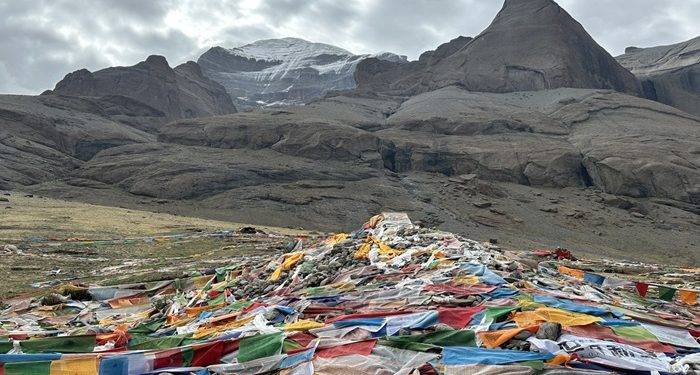Mount Kailash is a majestic mountain located in the remote region of the Transhimalaya range in the Tibet Autonomous Region of China. It stands at an amazing altitude of 6,638 meters (21,778 feet) above sea level.
One of the most remarkable features of Mount Kailash is its unique shape. In contrast to other jagged, uneven forms of other Himalaya peaks, Mount Kailash is known for having a nearly perfect symmetrical, pyramid-like structure.
Each mountain’s four sheer sides represent precisely one of the cardinal directions, giving the peak a majestic and enigmatic appearance. The mountain is often covered in snow, highlighting its ethereal beauty and its reputation as a holy and untouchable summit.
Here are the more detailed Facts about Mount Kailash, explaining its religious significance, cultural practices, and surrounding landscapes.
Religious Significance
Mount Kailash holds unrivaled religious importance for millions of people throughout Asia. The mountain is revered and imbued with heavenly presence by different religions, including Buddhism, Hinduism, Jainism, and the Bon. Pilgrims and adventurers alike embark on the Mount Kailash Tour, a sacred journey that involves a parikrama or kora—a circumambulation of the mountain, believed to cleanse sins and bring spiritual enlightenment.
Hinduism
Mount Kailash is a sacred place for Hindu devotees. They believed that one of the significant deities in the Hindu pantheon, Lord Shiva, resides at the top of the mountains.
Shiva is considered the “Destroyer” and “Transformer” within the Trimurti (including Brahma the Creator and Vishnu the Preserver as a trinity of supreme divinity). It is believed that Lord Shiva and his spouse Parvati reside in eternal meditation on Mount Kailash.
Moreover, the mountain is revered as the spiritual hub of the universe. Pilgrims have faith in making a trip to Kailash and practicing the rituals there can cleanse their sins and bring them closer to moksha (salvation from the cycle of birth and reincarnation).
Buddhism
Mount Kailash is known as Kang Rinpoche in Tibetan Buddhism, which means “Precious Snow Mountain.” It is considered the home of Demchok, also known as Chakrasamvara, a powerful tantric god who represents the highest state of enlightenment and supreme happiness.
The mountain is the main attraction and central hub of Tibetan methodology. It is believed to be the appearance of the Chakrasamvara Mandala that symbolizes the union of wisdom and compassion.
As per the Tibetan Buddhists, the pilgrimage to Mount Kailash lead towards spiritual awakening. Devotees seek to purify their spiritual energy and mind by attending a deeper understanding of the Dharma.
Jainism
Mount Kailash have also a great importance in Jainism. According to Jain beliefs, it is the place where the first Tirthankara (spiritual teacher and saviour), Rishabhanatha, attends Nirvana. It is the complete liberation from the cycle of life and death.
In Jain texts, the mountain known as Ashtapada is revered as a symbol of spiritual attainment and a great place of purity and sanctity. Jains embark on Mount Kailash on pilgrimages to commemorate the enlightenment of Rishabhanatha and to seek spiritual purity.
Bon Religion
The Bon religion is one of the indigenous Tibetan religions, which predates Buddhism. Bonpos (followers of Bon) regard Mount Kailash as a sacred place as they believe that the mountain is the dwelling place of their founder, Tonpa Shenrab Miwoche.
Tonpa Shenrab is said to have spiritual power as he is regarded as descended from the heavens and created the Bon tradition in the region. Kailash represents the cosmic axis and hub of the universe from where the divine and earthy realms intersect for the Bon practitioners.
A journey to Kailash is a great chance to renew one’s dedication to the path of the bon and to form a spiritual connection with the energies of the mountains.
Pilgrimage and Rituals
For the Devotees of these religions, one of the holiest rituals is the pilgrimage, or Kora, around Mount Kailash. The Circumambulation around the mountain provides a profound spiritual experience that represents the pursuit of spiritual enlightenment and the cycles of life, death, and rebirth.
The Kora Circumference
Performing Kora around Mount Kailash is the traditional ritual of the Buddhist religion. Kora is done by circulating the mountains consisting of a 52-kilometer (32-mile) path that passes through untamed terrain.
The Elevation ranges from 4,600 meters (15,091 feet) to over 5,600 meters (18,372 feet) crossing the circuit highest’s point, the Dolma La Pass.
Kora undertakes this challenging journey on foot frequently enduring erratic weather conditions, thin air, and rough landscapes. The Kora is performed with great devotion dedicating each step as a sacrifice to the divine, despite physical challenges.
Completing the Kora is believed to have immense spiritual advantages for Hindus and Buddhists. One complete circumambulation is said to cleanse a lifetime’s sins, while 108 circumambulations are believed to bring enlightenment.
Whereas, Jains and Bonpo perform the Kora with their spiritual meaning and rituals. The Pilgrimage typically takes three days while some devotees show extreme devotion and may prostrate themselves along the whole path, which might take up to three weeks.
The Hindus and Buddhists often do the Kora in a clockwise direction while Bonpo follows their ancient tradition by doing a counterclockwise circumambulation of the mountain.
Accessibility and Challenges
Reaching Mount Kailash is challenging due to its remote location in the far western region of Tibet. The nearest large city is Tibet’s capital, Lhasa, which requires special permission to visit.
The Journey to Mount Kailash from Lhasa takes several days of travel by road over the enormous, high-altitude Tibetan Plateau. The path is often rocky and unpaved, traversing through isolated areas having limited facilities for travellers.
The region’s altitude poses another significant obstacle. There is a great chance of suffering from altitude sickness because of the thin air at such high altitudes. This can cause anything from mild symptoms such as headaches and nausea to serious conditions that require medical treatment.
The harsh weather, which includes freezing temperatures and erratic patterns, adds to the difficulty of the journey. Despite these challenges, the pilgrimage to Mount Kailash is undertaken by thousands of pilgrims every year. They are drawn by their faith and the desire to have a spiritual connection.
Climbing Restrictions
Mount Kailash has never been climbed, unlike many other Himalayan peaks. This is not due to lack of interest or skills among mountaineers, rather, it’s because they deeply respect the religious significance of the region.
The mountain is regarded as a holy site and nobody is allowed to set foot on the mountain slopes. The Chinese government controls travel to the region and has upheld climbing prohibition, which is acknowledged by mountaineering communities throughout the world.
The unclimbed status of Mount Kailash further heightens its mystique and solidifies its role as a symbol of the divine and the unattainable. The mountain is evidence that some places on Earth are sacred sites and should remain untouched and unaltered in their natural condition.
Surrounding Attributes
Mount Kailash is not only a holy peak but also the centre hub of the region rich in both natural and spiritual significance. The presence of two nearby lakes, Lake Manasarovar and Lake Rakshastal, further enhances the purity of the region.
Lake Manasarover is situated southeast of Mount Kailash. It is a sacred freshwater lake having a significant symbolism of purity and healing in Hindu mythology.
On the other hand, Anavatapta Lake is a saltwater lake that is associated with darker methodology and is considered a lake of demon Ravana in Hindi belief. The combination of these two lakes in the centre of the Himalayas represents the duality of good and evil.
To sum up, Mount Kailash is more than simply a mountain. It is a symbol of spiritual inclination, a source of inspiration for millions of people, and a nature wonder untarnished by human ambition.
It is one of the most revered and enigmatic locations on earth having a religious significance, coupled with the physical and spiritual challenges.












